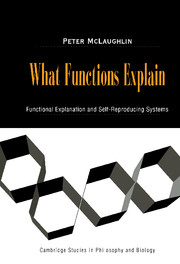7 - Artifacts and Organisms
Published online by Cambridge University Press: 12 August 2009
Summary
It is often assumed that the literal attribution of functions to artifacts is somehow natural and unproblematic, while the same attribution of functions to organic traits or social institutions might be merely metaphorical. I think that the opposite is more nearly the case: Artifacts have purposes; it is natural entities that have functions. On the other hand, it is certainly more than plausible that the attribution of purpose to an organ or a “natural” institution is indeed merely metaphorical (at least in this century). In such a case, we would be viewing them metaphorically, as if they were made for a purpose. We don't mean it literally, and if challenged, we would back off the assertion. There is, however, nothing metaphorical about ascribing purposes to artifacts; we mean this literally; but when we ascribe a function to them, we might in fact be engaging in mere metaphor. The function of a hammer, fishing rod, or knife is surely derivative of the purpose we have in making or appropriating them. If we were prevented from speaking of functions in connection with artifacts, we would not be left speechless: We would simply say purpose or intended effect, and the statement would, if anything, seem more natural. natural. We might encounter some slight difficulty with the parts of complex artifacts, because we may want to emphasize what they do in and for the system as opposed to what someone merely thinks they do or intended for them to do. But what a whole artifact is supposed to do is generally what it is intended to do. Talk about the functions of artifacts, while it is not entirely metaphysically innocent or immediately reducible to physical terms, involves us in no more metaphysics than do human intentions.
- Type
- Chapter
- Information
- What Functions ExplainFunctional Explanation and Self-Reproducing Systems, pp. 142 - 161Publisher: Cambridge University PressPrint publication year: 2000



